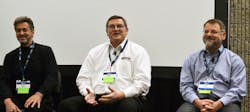Contractor Panel Explores HVACR Industry’s Leading Challenges
During its E360 Breakfast — held during the 2019 AHR Expo in Atlanta— Emerson hosted a panel discussion among HVACR contractors to glean their insights and opinions on the biggest challenges and emerging trends impacting their businesses. The contractor panel consisted of: Michael Duffee, owner of Restaurant Equipment Services, Inc.; Martin Hoover, owner of Empire Heating & Air Conditioning; and Jim Wharton, area vice president of Link Network, ABM. The discussion was moderated by Talbot Gee, chief executive officer of Heating, Air-conditioning & Refrigeration Distributors International (HARDI).
While the discussion spanned a wide range of topics, the bulk of the conversation was focused on three key issues:
- The regulatory uncertainty surrounding refrigerants
- The emergence of new technologies and analytics
- The ongoing labor shortage and its effects on recruitment and training
With different specialties and customer bases, each panelist brought a unique perspective on these topics, while also sharing similar challenges and customer experiences. In many ways, their firsthand interactions with customers provided rare insights into how these issues ultimately impact an end user. Today, there are many questions about which direction the industry might be headed, and this conversation shed some much-needed light on potential answers.
The service impacts of refrigerant regulations
Imagine showing up to a job site and not knowing which refrigerant is being used in the refrigeration or AC system. According to Hoover, this is an all too common scenario and a consequence of the rapidly changing refrigerant landscape. “When pressures aren’t reading true, we have to start from scratch with a total refrigerant evacuation, recovery and recharge before even attempting a diagnosis,” he stated.
Photo: from left to right are E360 panelists Michael Duffee, Martin Hoover and Jim Wharton.
The transition from a legacy refrigerant to a lower-GWP option comes at a cost, even for those that are considered drop-in replacements. Duffee said customers aren’t accustomed to seeing recovery and disposal fees tacked on to their bill, and this is adding competitive pressures to small contracting businesses. “Many companies may not be following proper recovery protocols to win business, which can put companies like ours at a disadvantage, and is obviously counterproductive from an environmental standpoint,” he said.
Gee, who moderated the panel discussion, asked if customers were even interested in the trend toward using lower-GWP refrigerants. Duffee noted that in his experience, cost considerations are most customers’ first priority. Even if their legacy systems are leaking, they’re reluctant to invest in equipment replacements. But, sooner or later an investment is inevitable, and that’s when they may be more open to a refrigerant discussion.
Wharton’s larger enterprise customer base has demonstrated more interest in making these investments, and his company is trying to frame this transition as an opportunity. “It’s challenging to align customers’ goals with the available equipment options, but there are some cases where federal and regional regulations are forcing a change,” he said.
Wharton added that this isn’t always good news for their customers, but he helps them understand the full scope of their investment, including: total lifecycle costs, energy efficiency and performance advantages.
But the refrigerant uncertainty is also adding complexity to the equipment decision-making process. Hoover said his customers are carefully evaluating the long-term viability of their selections: “The last thing they want after investing in a new system is for it to be phased out in four to five years due to a refrigerant change,” he said.
All panelists agreed that the industry would benefit greatly from the standardization of new refrigerants. “Preferably, we’d like to see one refrigerant, not five or six different options, to replace the old ones. He said that many contractors simply aren’t able to carry multiple varieties of refrigerants in their trucks at all times. And since these different refrigerants often have unique performance characteristics, the increasing variety only adds complexity to service calls.
The roles of new technologies, IoT and analytics
In recent years, the industry has experienced an influx of new electronic controls, connected technologies and data analytics enabled by the internet of things (IoT). As these technologies come online, each of the panelists had varying degrees of experience and interaction with them in the field — from component-level information to facility management insights.
Wharton explained that while data collection capabilities have been available for decades in different forms of energy management systems (EMS), too often operators don’t use them to their full potential. He said that many glance at their facility dashboards, see multiple areas running in the red (out-of-tolerance conditions), and may simply ignore them.
“Most operators know the way their building behaves, and if they see an alarm in a certain area, they also know whether it will go away or if they need to act on it,” said Wharton. He added that advanced data analytics are now offering more insights and the potential for additional tangible operational value by:
- Helping to drive informed decisionmaking
- Detecting performance trends
- Providing equipment diagnostics and troubleshooting
Hoover’s customer base crosses over into the residential arena where consumers are embracing whole-home automation. He said that these customers love getting notified of routine maintenance items such as when to change filters or fix a water clog or leak. But most importantly, they’re using systems to diagnose issues: “They like the fact that their home automation systems can let us know if something’s broken, so we can fix it before it affects their comfort levels,” said Hoover.
But from a technician’s perspective, Hoover insisted that these systems should not replace their ability to perform their own system diagnostics. He also stressed that diagnostics technology should not be seen as a substitute for proper technician training and education: “This doesn’t allow us to take someone straight out of high school and put them in the field, but it certainly makes it easier,” he added.
On-board compressor controls are also helping service contractors gain deeper insights into overall refrigeration system performance. Duffee cautioned that these enhancements only offer advantages in the hands of trained technicians: “If they’re not familiar with the technology, then you have to train them to avoid misdiagnosis, so there’s still the potential for things to go wrong,” he said.
Designing these sensor technologies to be resistant to the impacts of weather, water and humid conditions is a very important consideration for Duffee. As an example, he said, “In walk-in cooler environments, where it’s wet and sometimes caustic with the food and so forth, we’ve seen issues with consistency and where sensors and microprocessors can cause problems.”
Addressing the technician shortage
Throughout the panel discussion, the technician shortage was a recurring theme — regardless of the topic discussed. But once Gee turned the conversation specifically toward labor challenges, each panelist was eager to detail how it was impacting his business and what steps the industry could take to help improve the situation.
“We all would agree that labor is our number one issue,” said Hoover.
Finding qualified candidates starts at the company level, and each panelist had different approaches to the recruitment, onboarding and training processes. Hoover said recruitment never stops: “We’re a small company and we recruit 24/7/365,” he said. His company has developed an accelerated career progression plan for promising candidates, a plan specially designed to appeal to younger candidates new to the trade.
“We’ve divided career steps into 30-day increments, which engages the younger generation from the entry level and allows them to progress very quickly,” Hoover said. The goal is to accelerate their path to senior technician level and provide ample avenues for advancement.
Duffee said one of the biggest recruitment hurdles continues to be the negative public perception of the trade. “Let’s face it, the trades sometimes have a less than positive image, and our trade is very demanding,” he said. “We get our hands dirty, we work with heavy equipment, on rooftops in the pouring rain, in snow and 100-degree temps,” he added. Because of these factors, his company places a premium on candidates who are enthusiastic and possess positive personality traits.
According to Duffee, the industry needs a renewed focus at the high school level to promote the trades. As experienced technicians retire from the industry, Duffee sees the labor shortage only getting worse in the coming years: “We all should be aware and take whatever steps necessary to change this trend,” he concluded.
Adding to Duffee’s point, Wharton said that HVACR has fallen off the radar of many high schools with trade programs: “When you talk to high schools about trades, no one is talking about HVACR, so most don’t know it as an option,” he said. Instead, his company relies on alternative sources for recruitment, including:
- Former members of the U.S. military
- Vocational schools and technical colleges
- Career and technical organizations
From a training and preparedness perspective, Hoover explained that on-the-job experience is the final step toward developing a well-rounded technician: “Tech schools don’t really teach someone how to present yourself to a customer and have the proper communication skills,” he said.
New challenges bring new opportunities
With the introduction of new refrigerants and technologies, there’s no question that the HVACR service technician trade is more challenging than ever. But within this confluence of issues lie opportunities. As Hoover pointed out, “The technician shortage will drive up pay rates.” And the influx of connected technologies, software and analytics may help make the job more attractive to younger, tech-savvy candidates.
Emerson sources said creating awareness of HVACR technologies and career opportunities at high schools and technical colleges is one of the keys to attracting the next generation of candidates. Even as technologies advance to provide more proactive and predictive capabilities, the industry will still need highly skilled individuals in the field to apply their own experiential know-how to system diagnosis and repair.

